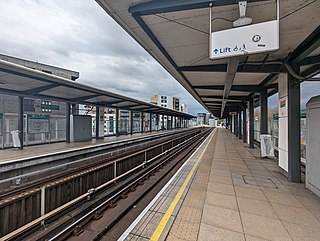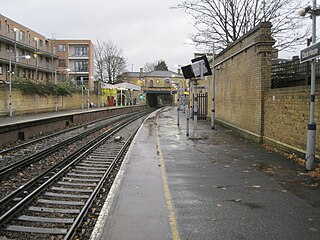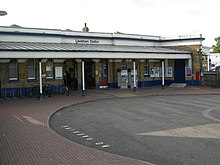
Woolwich Arsenal station is an interchange station in the heart of Woolwich in the Royal Borough of Greenwich for Docklands Light Railway (DLR) and National Rail services.

Limehouse is a National Rail and connected Docklands Light Railway (DLR) station in Limehouse, London, England. It is served by regional services operated by c2c to and from Fenchurch Street, and by light metro services provided by the DLR to and from Tower Gateway or Bank. On the main line, Limehouse is located 1 mile 58 chains (2.8 km) from Fenchurch Street and the following station is West Ham; on the DLR it is between Shadwell and Westferry in Travelcard Zone 2.

Greenwich station is about 400 m south-west of the district centre, in London, England. It is an interchange between National Rail between central London and Dartford, and the Docklands Light Railway (DLR) between Lewisham to the south and Docklands and the City of London. It is in Travelcard Zones 2 and 3.

Deptford Bridge is a Docklands Light Railway (DLR) station in Deptford, London in England. The station is elevated above both local roads and Deptford Creek, and is adjacent to Lewisham College and Deptford market.

Cutty Sarkfor Maritime Greenwich is a light metro station on the Docklands Light Railway (DLR) Bank-Lewisham Line in Greenwich, south-east London, so named for its proximity to the Cutty Sark in the Maritime Greenwich district. It is the most central of the Greenwich DLR stations, being situated in Greenwich town centre.

Shadwell is a Docklands Light Railway (DLR) station in Shadwell in east London, England and is between the terminals of Bank and Tower Gateway to the west and Limehouse to the east. The 1991 Bank extension joins the main DLR line just to the west of Shadwell. It is located near Shadwell railway station for London Overground services, in Travelcard Zone 2.

Heron Quays is a light metro station on the Docklands Light Railway (DLR) Bank to Lewisham Line in the Heron Quays area of Canary Wharf in East London. The station is situated on the Isle of Dogs and serves the southern part of the Canary Wharf office complex and is directly connected to the Jubilee Place underground shopping centre. The station is elevated and contained within one of the complex's office towers. It has an out of station interchange (OSI) for Canary Wharf Underground station on London Underground's Jubilee line. Through ticketing is allowed between both stations.

Canary Wharf is a Docklands Light Railway (DLR) station in Canary Wharf in East London. Located next to One Canada Square and between two parts of a shopping centre, it serves the Canary Wharf office complex. Each of its three tracks feature platforms on both sides, allowing for easy interchanges and access to surrounding buildings. The station is sheltered by a distinctive elliptical glass roof.

Crossharbour is a light metro station on the Docklands Light Railway (DLR) Bank-Lewisham Line in Cubitt Town, East London. The station is situated on the Isle of Dogs and is between Mudchute and South Quay stations and is in Travelcard Zone 2.

Island Gardens is a Docklands Light Railway (DLR) station next to Island Gardens on the Isle of Dogs, East London. It is just north of the River Thames and is close to the southern tip of the Isle of Dogs and the River Thames.

Mudchute is a Docklands Light Railway (DLR) station on the Isle of Dogs, next to Mudchute in London, England. The station is situated in the Millwall area and is in Travelcard Zone 2. The name of the area refers to the engineering overspill when Millwall Dock was being created in the 1840s. Spoil from the excavation of the Dock and silt from its channels and waterways were dumped on nearby land, creating "The Mudchute", which quickly established itself as a wildlife habitat and adventuring location for local children.

Abbey Wood is a National Rail station in Abbey Wood in southeast London, England. It is between Plumstead and Belvedere stations on the North Kent Line. It is 11 miles 43 chains (18.6 km) measured from London Charing Cross, with services to central London routed via Greenwich or Lewisham, and Elizabeth line services to Paddington and Reading via Canary Wharf and Liverpool Street. The station is managed by Transport for London with passenger services provided by Southeastern, Thameslink and the Elizabeth line. It is the closest railway station to the suburb of Thamesmead, which is connected to the station by local buses. The station platforms are located in the Royal Borough of Greenwich with the station entrance in the London Borough of Bexley.

Poplar is a Docklands Light Railway (DLR) station in Poplar in London, England. Poplar is a cross-platform interchange station for three of the six lines on the DLR making it one of the busiest stations on the network in terms of services. It is also nearby the Canary Wharf Station on Crossrail's Elizabeth Line.

West India Quay is a Docklands Light Railway (DLR) station in Canary Wharf’s West India Quay. It is located at the point where the line from Lewisham splits into branches to Tower Gateway/Bank and Stratford. The next stations on each line are Canary Wharf DLR station, Westferry and Poplar DLR station. The station is in Travelcard Zone 2.

All Saints is a Docklands Light Railway (DLR) station in Poplar in East London. The station is named after nearby All Saints, a Church of England parish church dating from 1821 to 1823. The station entrance is on the East India Dock Road, the high street of Poplar and is opposite Chrisp Street Market while adjacent to the Poplar Baths, it also has two rail sidings directly west of the station forming part of Poplar DLR depot.

Stratford International is a National Rail station in Stratford and a separate Docklands Light Railway (DLR) station nearby, located in East Village in London. Despite its name, no international services stop at the station; plans for it to be served by Eurostar trains never came to fruition. The National Rail platforms are served by Southeastern trains on the High Speed 1 route originating at London St Pancras International. On the DLR, it is a terminus – one of seven end-of-the-line termini – for local services via Canning Town and London City Airport.

Elmers End is a railway station and tram terminus in Elmers End, south London, England. It is in the London Borough of Bromley and on the railway it is 11 miles 7 chains (17.8 km) down the line from London Charing Cross.

Clock House railway station is in the London Borough of Bromley in south east London, in Travelcard Zone 4 between Beckenham and Penge. It is 10 miles 23 chains (16.6 km) down the line from London Charing Cross. The station and all trains serving it are operated by Southeastern on the Hayes line.

Eden Park railway station serves Eden Park in the London Borough of Bromley in south east London, in Travelcard Zone 5. It is therefore possible to use an Oyster card at the station. It is 12 miles 34 chains (20.0 km) down the line from London Charing Cross. The station and all trains serving it is operated by Southeastern on the Hayes line. The trains are electric, powered by a third rail.

Langdon Park is a Docklands Light Railway (DLR) station in Poplar in Greater London, England. The station is between All Saints and Devons Road stations on the Stratford-Lewisham Line. Construction of the infill station began on 17 November 2006, and the first day of operation was 9 December 2007.


























